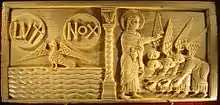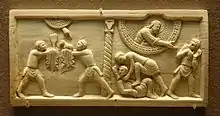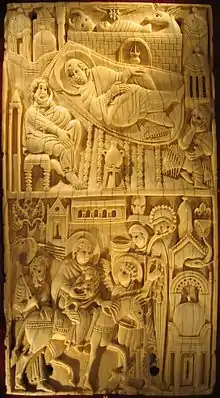Salerno Ivories
The Salerno Ivories are a collection of over 70 Biblical ivory plaques from around the 11th or 12th century that contain elements of Early Christian, Byzantine, and Islamic art as well as influences from Western Romanesque and Anglo-Saxon art.[1] It is the largest unified set of ivory carvings preserved from the pre-Gothic Middle Ages.,[2][3] and depicts narrative scenes from both the Old and New Testaments. The majority of the plaques are housed in the Diocesan Museum of the Cathedral of Salerno, which is where the group's main namesake comes from.[2] It is supposed the ivories originated in either Salerno and Amalfi, which both contain identified ivory workshops, however neither has been definitively linked to the plaques so the city of origin remains unknown.[4][5] The panel's origins in a twelfth-century Sicilian or Levantine workshop has also been considered, as well as possible monastic bonds or affiliations to the Norman court.[1] Smaller groups of the plaques and fragments of panels are currently housed in different museum collections in Europe and America,[4] including the Metropolitan Museum of Art in New York, the Louvre in Paris, and the Museum of Fine Arts in Budapest.[2]

The plaques make up one part of a broad group of ivory artifacts from the same era and region of southern Italy. These consist of collections of objects such as oliphants, bone-and-ivory boxes, chess pieces, Siculo-Arabic boxes, Italo-Byzantine ivories and the Farfa Casket.[4]
Historical Background and Origin

The earliest documentation of the ivories was in the inventories of the Salerno Cathedral during the early sixteenth century.[1] A lack of further written sources causes debate over when and where the ivories were carved, who commissioned them, the arrangement of the panels, and the geographical and cultural origins of the artists.[1] The dating of the ivories spans from the later eleventh to the mid twelfth century. The original sequence and arrangement for the ivories are unknown.[6] Scholars have proposed the plaques were part of a throne, casket or door, but no evidence has been found to support this.[3] The only documentation discussing an arrangement order for the plaques was at the death of the Archbishop of the Cathedral Lucio Sanseverino in 1623, when he requested them hung on an altar at the Cathedral.[6]
There are various possibilities for the origin of the ivories. One possibility is that they were commissioned by the Archbishop Alfanus after the consecration of the Salerno Cathedral in the last quarter of the eleventh century. Alfanus has been connected with the making of a similar cycle at Monte Cassino.[2] Another theory is that the panels were ordered by the Archbishop of Salerno, William of Ravenna, around 1140 for the refurbishing of the Cathedral's altar, an event that was documented in 1137.[1]
Description

The Salerno ivories consist of approximately forty figurative plaques, thirteen medallions, and seventeen border carving fragments.[7][3] The majority of the Salerno ivory panels are well-preserved and in excellent condition.[2] They are carved in relief into flat segments of ivory.[4][8] The plaques vary in size. Eighteen of the figurative plaques depict scenes and figures from the Old Testament, while twenty plaques and two halves of panels depict scenes from the New Testament.[2][7] The Old Testament sequence average 12 cm to 24 cm wide and about 9 cm tall, while many of the New Testament plaques average 24 cm tall and 12 cm wide.[2] Cornices and borders average from 21–25 cm long by about 7 cm wide.[9] The supporting columns are about 23 cm x 2 cm and the busts are 6 cm squared.[9] Most of the plaques are divided into an upper half and lower half and contain two separate scenes, with a few exceptions.[2][3]
The plaques illustrate a comprehensive linear narrative of the life of Christ and the most important phases of his life, from his birth and infancy to his Resurrection.[2] The Old Testament series of plaques contains a series of scenes beginning with Creation (pictured at top of page) and then recounting the stories of Adam and Eve, Cain and Abel, Noah, Abraham, Isaac, Jacob, and Moses, ending with Moses Receiving the Laws.[2][7] Unlike other late medieval works where episodes from the Old and New Testaments were illustrated side by side, the two Testaments are separate and not conjunct in the Salerno Ivories.[2]
Each plaque is carved in high relief, with figures, objects and animals in the scene appearing to come out of the ivory panel. Some of the different figures have glass eyes still intact in colors like blue, black or red.[10] Each scene is bordered around the edges of the ivory and the entire series has detached decorative cornices, borders and colonnettes.[10] The cornices and borders contain inhabited scrolls, plants and cornucopias, while the colonnettes contain a decorative twisting column. There are also small square-and-circle bust portraits of different Apostles and Donors.[10]
Scholars use manuscript illustrations and contemporary ivory monuments as sources for the iconography of the Salerno Ivories.[7] These include a sixth-century manuscript called the Cotton Genesis as well as Middle Byzantine Octateuch manuscripts, which lend traditions of Old Testament illustrations and stylistic influences to the Salerno Ivories.[2] Another sizable group of ivories called the Grado Chair series were used as a model for several of the New Testament scenes.[2]
Significance
The Ivories are primarily understood as Christian religious works, but some scholars have also proposed they held a political significance as well.[7] Since there are no concrete facts to support this, just theories and observations, the truth of the ivories' purpose remains unknown.[7]
References
- Müller, Kathrin. “OLD AND NEW. Divine Revelation in the Salerno Ivories.” Mitteilungen des Kunsthistorischen Institutes in Florenz, vol. 54, no. 1, 2010, pp. 1–30. JSTOR, JSTOR, www.jstor.org/stable/41414763.
- Bergman, Robert P. The Salerno Ivories : Ars Sacra from Medieval Amalfi. Cambridge, Mass.: Harvard University Press, pgs.1-2, 1980.
- Corey, Elizabeth C. "The Two Great Lights: Regnum And Sacerdotium In The Salerno Ivories." History of Political Thought 34, no. 1, pg. 3, 2013.
- Eastmond, The Salerno Ivories: Objects, Histories, Contexts. Berlin: Gebr. Mann Verlag, pgs.99, 97-109, 103-106, 2016.
- Bergman, Robert P. “A School of Romanesque Ivory Carving in Amalfi.” Metropolitan Museum Journal, vol. 9, pg. 183, 1974, web.
- Dell’Acqua, Francesca. The Salerno Ivories: Objects, Histories, Contexts. Berlin: Gebr. Mann Verlag, pg. 211, 2016.
- Corey, Elizabeth C. "The Purposeful Patron: Political Covenant In The Salerno Ivories." Viator: Medieval And Renaissance Studies, Vol 40, No 2, pg. 55, 2009.
- Wixom, William D. "Eleven Additions to the Medieval Collection." The Bulletin of the Cleveland Museum of Art 66, no. 3, pg. 87-9, 1979.
- Kunsthistorisches Institut, Max-Planck-Institut, Iparmüvészeti Múzeum, The Metropolitan Museum, Francesca Dell’Acqua, Foto Scala, Firenze/bpk, Bildagentur für Kunst, Kultur und Geschichte, Museum für Kunst and Gewerbe, pg. 329-38, 339-354. The Salerno Ivories: Objects, Histories, Contexts. Berlin: Gebr. Mann Verlag, 2015.
- Museo Diocesano The Salerno Ivories: Objects, Histories, Contexts. Berlin: Gebr. Mann Verlag, pgs. 28-54, 355; 2015.